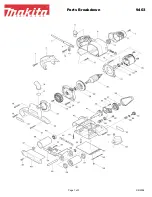
8
Unpacking
Due to modern mass production techniques, it is unlikely
that your GMC Power Tool is faulty or that a part is missing.
If you find anything wrong, do not operate the tool until the
parts have been replaced or the fault has been rectified.
Failure to do so could result in serious personal injury.
Switching on and off
Connect the plug to the
power supply.
Pull the on/off trigger (2) upward
to start the sander. (Fig.A)
Release the trigger to turn off
the sander.
By pulling the trigger on and
pressing the lock on button (3),
you can lock the sander on.
Pulling the switch on again and
releasing it turns the switch off.
(Fig. B)
Using the sander
The sander is designed for
sanding wood, metal, plastic and
similar materials. It can be used
for sanding back and finishing the surface.
This sander is a handy size for medium jobs.
WARNING.
Wear safety goggles, a dust mask and
ear defenders.The whole sanding pad must rest on
the workpiece.
Switch the sander on while it is placed on the workpiece
and move it over the surface to be smoothed in a
circular motion.
Grip the main handle (4) in one hand and push down on the
front of the handle with the other hand.
Take care to hold the sander parallel to the work.
Use moderate pressure only.
If there are still marks on your work after sanding, try either
going back to a coarser grade and sanding the marks out
before recommencing with the original choice of grit, or try
using a new piece of sandpaper to eliminate the unwanted
marks before going on to a finer grit and finishing the job.
WARNING.
Do not use the sander in wet or
damp conditions.
Fitting a sanding sheet
CAUTION.
Switch off the sander and disconnect it from the
power point.
With hook & loop type sanding
sheets, simply press the sheet
to the platen (7), taking care to
align the holes in the sanding
sheet with those in the platen.
(Fig. C)
Ordinary (non-hook & loop type)
sanding sheets can also be
used. Release the clamps (8)
from both sides of the sander.
(Fig. D)
Insert the end of the sandpaper
under the front clamp and pull
the paper tight over the platen
ensuring the holes align with
those in the platen and then
clamp the other end.
The paper should be kept
tightly clamped over the platen, otherwise there could be
excessive wear of the
cushion material.
WARNING.
Do not continue to use the sander with a
sanding sheet that is overworn or damaged.
WARNING.
Do not use the same sanding sheet for wood
and metal. Metal particles become embedded in the
sandpaper and will scour a wooden surface.
A
B
C
D






























